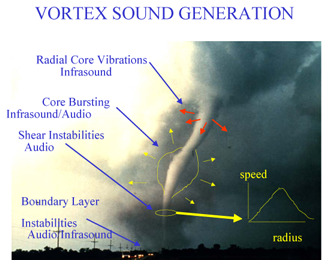




 Wiki:
Wiki:
Supercell relationship
Tornadoes often develop from a class of thunderstorms known as supercells. Supercells contain mesocyclones, an area of organized rotation a few miles up in the atmosphere, usually 1–6 miles (2–10 km) across. Most intense tornadoes (EF3 to EF5 on the Enhanced Fujita Scale) develop from supercells. In addition to tornadoes, very heavy rain, frequent lightning, strong wind gusts, and hail are common in such storms.
Most tornadoes from supercells follow a recognizable life cycle. That begins when increasing rainfall drags with it an area of quickly descending air known as the rear flank downdraft (RFD). This downdraft accelerates as it approaches the ground, and drags the supercell's rotating mesocyclone towards the ground with it.
Formation
As the mesocyclone lowers below the cloud base, it begins to take in cool, moist air from the downdraft region of the storm. This convergence of warm air in the updraft, and this cool air, causes a rotating wall cloud to form. The RFD also focuses the mesocyclone's base, causing it to siphon air from a smaller and smaller area on the ground. As the updraft intensifies, it creates an area of low pressure at the surface. This pulls the focused mesocyclone down, in the form of a visible condensation funnel. As the funnel descends, the RFD also reaches the ground, creating a gust front that can cause severe damage a good distance from the tornado. Usually, the funnel cloud begins causing damage on the ground (becoming a tornado) within a few minutes of the RFD reaching the ground.
Maturity
Initially, the tornado has a good source of warm, moist inflow to power it, so it grows until it reaches the "mature stage". This can last anywhere from a few minutes to more than an hour, and during that time a tornado often causes the most damage, and in rare cases can be more than one mile (1.6 km) across. Meanwhile, the RFD, now an area of cool surface winds, begins to wrap around the tornado, cutting off the inflow of warm air which feeds the tornado.[15]
Dissipation
As the RFD completely wraps around and chokes off the tornado's air supply, the vortex begins to weaken, and become thin and rope-like. This is the "dissipating stage"; often lasting no more than a few minutes, after which the tornado fizzles. During this stage the shape of the tornado becomes highly influenced by the winds of the parent storm, and can be blown into fantastic patterns. Even though the tornado is dissipating, it is still capable of causing damage. The storm is contracting into a rope-like tube and, like the ice skater who pulls her arms in to spin faster, winds can increase at this point.
As the tornado enters the dissipating stage, its associated mesocyclone often weakens as well, as the rear flank downdraft cuts off the inflow powering it. In particular, intense supercells tornadoes can develop cyclically. As the first mesocyclone and associated tornado dissipate, the storm's inflow may be concentrated into a new area closer to the center of the storm. If a new mesocyclone develops, the cycle may start again, producing one or more new tornadoes. Occasionally, the old (occluded) mesocyclone and the new mesocyclone produce a tornado at the same time.
Although this is a widely accepted theory for how most tornadoes form, live, and die, it does not explain the formation of smaller tornadoes, such as landspouts, long-lived tornadoes, or tornadoes with multiple vortices. These each have different mechanisms which influence their development—however, most tornadoes follow a pattern similar to this one.
請閱讀更多我的博客文章>>>